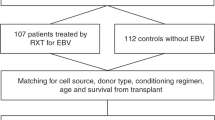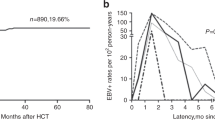Abstract
In allogeneic hematopoietic stem cell transplantation recipients, reactivation of Epstein–Barr virus (EBV) can cause post-transplantation lymphoproliferative disorder (PTLD), which may rapidly progress to multiorgan failure and even death. Development of EBV PTLD correlates very closely with use of anti-thymocyte globulin (ATG) and type of transplant. To assess the incidences and clinical features of EBV DNAemia and PTLD in the setting of stem cell transplantation using unmanipulated G-CSF-primed allogeneic peripheral blood stem cells as graft, we performed a retrospective analysis of stem cell transplantation from HLA-matched sibling donors (MSD-SCT, n = 90) or HLA-haploidentical related donors (HID-SCT, n = 110) in patients with hematological malignancies. All of HID-SCT recipients and 27.8% of MSD-SCT recipients received an ATG-containing conditioning regimen. One-year cumulative incidence of EBV DNAemia was 44.1%, ranging from 4.8% in MSD-SCT recipients not using ATG to 20.0% in MSD-SCT recipients using ATG, and 73.7% in HID-SCT recipients. Risk factors for EBV reactivation included use of ATG (p = 0.008), male donor (p = 0.034), and cytomegalovirus DNAemia (p < 0.001). One-year incidence of EBV PTLD was 11.9%, ranging from 1.8% in recipients of MSD-SCT not using ATG to 4.4% in recipients of MSD-SCT using ATG, and 23.5% in recipients of HID-SCT. Risk factors for PTLD after HID-SCT included in fludarabine-containing conditioning regimen (p = 0.010), cytomegalovirus DNAemia (p = 0.036), and patient’s age < 40-yr (p = 0.032). Two-year non-relapse mortality was higher for patients with EBV DNAemia than those without EBV DNAemia (35.8% vs. 15.3%, p = 0.002). One-year relapse-free survival and overall survival among patients with PTLD were 40.2% and 44.9%, respectively, as opposed to 63.4% and 68.4% among patients without PTLD (both p < 0.05). In multivariate analyses, EBV DNAemia predicted a lower risk of relapse (p = 0.025), while PTLD was a marginally significant predictor of relapse (p = 0.092). This study identified patients at risk of EBV reactivation and PTLD after unmanipulated allogeneic peripheral blood stem cell transplantation.




Similar content being viewed by others
References
Styczynski J, Gil L, Tridello G, Ljungman P, Donnelly JP, van der Velden W, Omar H, Martino R, Halkes C, Faraci M, Theunissen K, Kalwak K, Hubacek P, Sica S, Nozzoli C, Fagioli F, Matthes S, Diaz MA, Migliavacca M, Balduzzi A, Tomaszewska A, Camara Rde L, van Biezen A, Hoek J, Iacobelli S, Einsele H, Cesaro S Infectious Diseases Working Party of the European Group for Blood and Marrow Transplantation (2013) Response to rituximab-based therapy and risk factor analysis in Epstein Barr Virus-related lymphoproliferative disorder after hematopoietic stem cell transplant in children and adults: a study from the Infectious Diseases Working Party of the European Group for Blood and Marrow Transplantation. Clin Infect Dis 57(6):794–802
Ocheni S, Kroeger N, Zabelina T, Sobottka I, Ayuk F, Wolschke C, Muth A, Lellek H, Petersen L, Erttmann R, Kabisch H, Zander AR, Bacher U (2008) EBV reactivation and post transplant lymphoproliferative disorders following allogeneic SCT. Bone Marrow Transplant 42(3):181–186
Worth A, Conyers R, Cohen J, Jagani M, Chiesa R, Rao K, Goulden N, Veys P, Amrolia PJ (2011) Pre-emptive rituximab based on viraemia and T cell reconstitution: a highly effective strategy for the prevention of Epstein-Barr virus-associated lymphoproliferative disease following stem cell transplantation. Br J Haematol 155(3):377–385
García-Cadenas I, Castillo N, Martino R, Barba P, Esquirol A, Novelli S, Orti G, Garrido A, Saavedra S, Moreno C, Granell M, Briones J, Brunet S, Navarro F, Ruiz I, Rabella N, Valcárcel D, Sierra J (2015) Impact of Epstein Barr virus-related complications after high-risk allo-SCT in the era of pre-emptive rituximab. Bone Marrow Transplant 50(4):579–584
Cesaro S, Pegoraro A, Tridello G, Calore E, Pillon M, Varotto S, Abate D, Barzon L, Mengoli C, Carli M, Messina C (2010) A prospective study on modulation of immunosuppression for Epstein-Barr virus reactivation in pediatric patients who underwent unrelated hematopoietic stem-cell transplantation. Transplantation 89(12):1533–1540
Uhlin M, Wikell H, Sundin M et al (2014) Risk factors for Epstein-Barr virus-related post-transplant lymphoproliferative disease after allogeneic hematopoietic stem cell transplantation. Haematologica. 99(2):346–352
Landgren O, Gilbert ES, Rizzo JD, Socié G, Banks PM, Sobocinski KA, Horowitz MM, Jaffe ES, Kingma DW, Travis LB, Flowers ME, Martin PJ, Deeg HJ, Curtis RE (2009) Risk factors for lymphoproliferative disorders after allogeneic hematopoietic cell transplantation. Blood 113(20):4992–5001
Dierickx D, Habermann TM (2018) Post-transplantation lymphoproliferative disorders in adults. N Engl J Med 378(6):549–562
Bollard CM, Heslop HE (2016) T cells for viral infections after allogeneic hematopoietic stem cell transplant. Blood 127(26):3331–3340
Curtis RE, Travis LB, Rowlings PA, Socié G, Kingma DW, Banks PM, Jaffe ES, Sale GE, Horowitz MM, Witherspoon RP, Shriner DA, Weisdorf DJ, Kolb HJ, Sullivan KM, Sobocinski KA, Gale RP, Hoover RN, Fraumeni JF Jr, Deeg HJ (1999) Risk of lymphoproliferative disorders after bone marrow transplantation: a multi-institutional study. Blood 94(7):2208–2216
Styczynski J, Reusser P, Einsele H, de la Camara R, Cordonnier C, Ward KN, Ljungman P, Engelhard D; Second European Conference on Infections in Leukemia (2009) Management of HSV, VZV and EBV infections in patients with hematological malignancies and after SCT: guidelines from the Second European Conference on Infections in Leukemia. Bone Marrow Transplant 43(10):757–770
Przepiorka D, Weisdorf D, Martin P, Klingemann HG, Beatty P, Hows J, Thomas ED (1995) 1994 Consensus conference on acute GVHD grading. Bone Marrow Transplant 15(6):825–828
Jagasia MH, Greinix HT, Arora M, Williams KM, Wolff D, Cowen EW, Palmer J, Weisdorf D, Treister NS, Cheng GS, Kerr H, Stratton P, Duarte RF, McDonald GB, Inamoto Y, Vigorito A, Arai S, Datiles MB, Jacobsohn D, Heller T, Kitko CL, Mitchell SA, Martin PJ, Shulman H, Wu RS, Cutler CS, Vogelsang GB, Lee SJ, Pavletic SZ, Flowers ME (2015) National Institutes of Health consensus development project on criteria for clinical trials in chronic graft-versus-host disease: I. the 2014 Diagnosis and Staging Working Group report. Biol Blood Marrow Transplant 21(3):389–401
Scrucca L, Santucci A, Aversa F (2007) Competing risk analysis using R: an easy guide for clinicians. Bone Marrow Transplant 40(4):381–387
Scrucca L, Santucci A, Aversa F (2010) Regression modeling of competing risk using R: an in depth guide for clinicians. Bone Marrow Transplant 45(9):1388–1395
Arcenas R, Widen RH (2002) Epstein-Barr virus reactivation after superinfection of the BJAB-B1 and P3HR-1 cell lines with cytomegalovirus. BMC Microbiol 2:20
Zallio F, Primon V, Tamiazzo S, Pini M, Baraldi A, Corsetti MT, Gotta F, Bertassello C, Salvi F, Rocchetti A, Levis A (2013) Epstein-Barr virus reactivation in allogeneic stem cell transplantation is highly related to cytomegalovirus reactivation. Clin Transpl 27(4):E491–E497
Papadopoulou A, Gerdemann U, Katari UL, Tzannou I, Liu H, Martinez C, Leung K, Carrum G, Gee AP, Vera JF, Krance RA, Brenner MK, Rooney CM, Heslop HE, Leen AM (2014) Activity of broad-spectrum T cells as treatment for AdV, EBV, CMV, BKV, and HHV6 infections after HSCT. Sci Transl Med 6(242):242ra83
Janeczko M, Mielcarek M, Rybka B, Ryczan-Krawczyk R, Noworolska-Sauren D, Kałwak K (2016) Immune recovery and the risk of CMV/ EBV reactivation in children post allogeneic haematopoietic stem cell transplantation. Cent Eur J Immunol 41(3):287–296
Klyuchnikov E, Asenova S, Kern W, Kilinc G, Ayuk F, Wiedemann B, Lioznov M, Freiberger P, Zalyalov Y, Zander AR, Kröger N, Bacher U (2010) Post-transplant immune reconstitution after unrelated allogeneic stem cell transplant in patients with acute myeloid leukemia. Leuk Lymphoma 51(8):1450–1463
Styczynski J, Einsele H, Gil L, Ljungman P (2009) Outcome of treatment of Epstein-Barr viruserelated post-transplant lymphoproliferative disorder in hematopoietic stem cell recipients: a comprehensive review of reported cases. Transpl Infect Dis 11(5):383–392
Styczynski J, van der Velden W, Fox CP, Engelhard D, de la Camara R, Cordonnier C, Ljungman P; Sixth European Conference on Infections in Leukemia, a joint venture of the Infectious Diseases Working Party of the European Society of Blood and Marrow Transplantation (EBMT-IDWP), the Infectious Diseases Group of the European Organization for Research and Treatment of Cancer (EORTC-IDG), the International Immunocompromised Host Society (ICHS) and the European Leukemia Net (ELN) (2016) Management of Epstein-Barr Virus infections and post-transplant lymphoproliferative disorders in patients after allogeneic hematopoietic stem cell transplantation: Sixth European Conference on Infections in Leukemia (ECIL-6) guidelines. Haematologica 101(7):803–811
Xu LP, Zhang CL, Mo XD, Zhang XH, Chen H, Han W, Chen YH, Wang Y, Yan CH, Wang JZ, Wang FR, Zhao T, Liu YR, Liu KY, Huang XJ (2015) Epstein-Barr virus-related post-transplantation lymphoproliferative disorder after unmanipulated human leukocyte antigen haploidentical hematopoietic stem cell transplantation: incidence, risk factors, treatment, and clinical outcomes. Biol Blood Marrow Transplant 21(12):2185–2191
Abruzzo LV, Rosales CM, Medeiros LJ, Vega F, Luthra R, Manning JT, Keating MJ, Jones D (2002) Epstein-Barr virus-positive B-cell lymphoproliferative disorders arising in immunodeficient patients previously treated with fludarabine for low-grade B-cell neoplasms. Am J Surg Pathol 26(5):630–636
Lange A, Klimczak A, Dlubek D, Dybko J (2003) B-cell lymphoproliferative syndrome and peripheral blood CD20+ cells expansion after hematopoietic stem cell transplantation: association with fludarabine and anti-thymocyte globulin containing conditioning regimen. Transplant Proc 35(8):3093–3095
Dharnidharka VR, Tejani AH, Ho PL, Harmon WE (2002) Post-transplant lymphoproliferative disorder in the United States: young Caucasian males are at highest risk. Am J Transplant 2(10):993–998
Funding
This work was partially supported by grants from the National Natural Science Foundation of China (81770203 to D-H L, 81670135 and 81870109 to X-N G), Natural Science Foundation of Beijing (7162174 to J L) and National Clinical Specialist Focus on Military Construction Projects.
Author information
Authors and Affiliations
Corresponding authors
Ethics declarations
This study was approved by the Ethics Committee of Chinese PLA General Hospital, and signed informed consents were obtained from all patients prior to transplantation in accordance with principles of Declaration of Helsinki.
Conflict of interest
The authors declare no competing interests.
Additional information
Publisher’s note
Springer Nature remains neutral with regard to jurisdictional claims in published maps and institutional affiliations.
Electronic supplementary material
ESM 1
(DOCX 7055 kb)
Rights and permissions
About this article
Cite this article
Gao, XN., Lin, J., Wang, LJ. et al. Risk factors and clinical outcomes of Epstein–Barr virus DNAemia and post-transplant lymphoproliferative disorders after haploidentical and matched-sibling PBSCT in patients with hematologic malignancies. Ann Hematol 98, 2163–2177 (2019). https://doi.org/10.1007/s00277-019-03742-7
Received:
Accepted:
Published:
Issue Date:
DOI: https://doi.org/10.1007/s00277-019-03742-7




